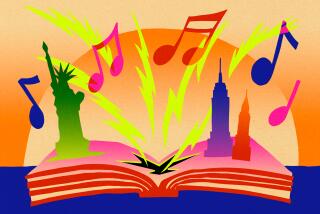They Are Bound for a Place in History : Books: Earning a niche in the World Book Encyclopedia, the backbone of elementary student research for years, carries a certain resonance.
- Share via
NEW YORK — Woody Allen and Anorexia Nervosa were inducted in 1981. Brown Lung, Endorphin and Volkswagen made it the next year. Then came Barcoding, Tofu and Josef Mengele.
This year, it finally became Reggae’s turn to grace the pages of the World Book Encyclopedia, the leather-bound intellectual cheat sheet used without fail by generations of students.
Manuel Antonio Noriega (“a military leader who controlled Panama”) also made the grade for the first time this year, as did Joe Montana.
It may not be the Baseball Hall of Fame, or even the Grammys, but a niche in the 1991 World Book--released recently--does carry a certain resonance.
“There’s one heck of a lot of discussion about who is in and who isn’t,” said Pat Higgins-Crane, a spokeswoman for the encyclopedia, the most popular publication of its kind in the country. “It is nothing anybody here takes lightly.”
But history and the World Book can be cruel. For nearly every addition, some poor slacker gets the boot. This year, it’s miler Jim Ryun’s turn to slip out of history. Also Plexiglas, which the scientific advisory board decided could be included in the description for Acrylic.
Believe it or not, Shibasaburo Kitafato, the eminent Japanese bacteriologist who died in 1931, also was evicted this year. Go figure.
The World Book people say they sell as many sets of their 22-volume, 14,000-page product each year--prices range from $500 to $800, depending on binding--as their next three rivals combined. Since nobody in the industry releases figures, there’s no way to be sure they’re right. But given the encyclopedia’s pithy biographies and short, snappy summaries of broad world events, it could be argued that few sets of books have had more influence in the 20th Century.
“It has been the backbone of elementary student research foryears,” said Kenneth Kister, a Florida librarian who has written extensively on encyclopedias. “Some might find the Britannica more erudite, but I don’t think any has been as influential.”
The World Book Encyclopedia is the last of its genre to rely heavily on classroom reaction when planning its extensive annual revisions. Several hundred elementary schools monitor their students to see what they look up and what they don’t, then teachers send more than 100,000 cards each year to the publisher so it can get a sense of who wants what.
Despite its massive and unquestioned popularity, or perhaps because of it, there has always been a feeling among some academics that reliance on the World Book is like an addiction to USA Today--breezy, informative, but perhaps less filling than the other brands.
The World Book isn’t lowbrow and it isn’t highbrow. That makes it easy to attack from both sides. The editors use what they describe as a “pyramid” structure to craft their entries. What this means is that the entry for, say, Dog is written to appeal to the average third-grader, the age at which editors believe children are most likely to refer to that topic.
The entry for AIDS, on the other hand, is supposed to appeal to somebody in high school. The result, in theory, is a family classic, something that should have a little in it for everyone.
“It’s one of those things that seems comforting in a home,” said Sandy Whiteley, editor of Reference Books Bulletin and an expert on encyclopedias. “For many families, it’s always been there. The World Book really appeals to parents just thinking about educating their kids. It’s a product that has always been hard to reject.”
More to Read
Sign up for our Book Club newsletter
Get the latest news, events and more from the Los Angeles Times Book Club, and help us get L.A. reading and talking.
You may occasionally receive promotional content from the Los Angeles Times.









